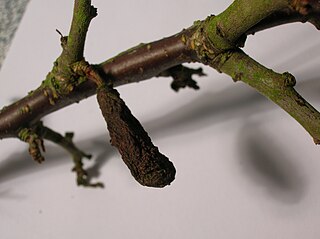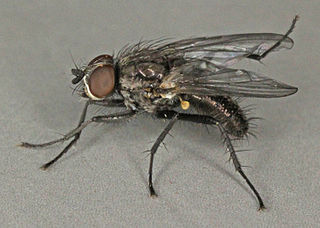
Eriophyes tiliae is a mite that forms the lime nail gall or bugle gall. It develops in a chemically induced gall; an erect, oblique or curved distortion rising up from the upper surface of the leaves of the lime (linden) trees, such as the large-leaved lime tree Tilia platyphyllos, the common lime tree Tilia × europaea, etc.

Taphrina pruni is a fungal plant pathogen of blackthorn that causes the pocket or bladder plum gall, a chemically induced distortion of the fruit (sloes), producing swollen on one side, otherwise deformed and flattened fruit gall without a stone. The twigs on infected plants may also be deformed with small strap-shaped leaves.

Taphrina padi is a fungal plant pathogen that induces the form of pocket plum gall that occurs on bird cherry. The gall is a chemically induced distortion of the fruits, which are swollen, hollow, curved and greatly elongated, without a seed or stone, but retaining the style. The twigs on infected plants may also be deformed with small strap-shaped leaves.

Puccinia poarum, a species of fungus, known as the coltsfoot gall rust, or meadow grass rust, is a plant pathogen. This fungal parasite forms a yellow to orange gall, 1–2 cm in diameter, on the underside of leaves of coltsfoot. It also infects but does not gall grasses of the family Poaceae. P. poarum is a genetically diverse species that has been reported on at least seventy plant hosts. It was originally found on Poa fertilis and Poa nemoralis in Denmark in 1877.

Dasineura crataegi, the hawthorn button-top gall-midge, is a dipteran gall-midge. It causes the hawthorn button-top gall, which develops in the terminal shoots of common hawthorn, Crataegus monogyna Jacq., Midland hawthorn C laevigata (Poir.) DC and their hybrid, C × media Bechst. Synonyms are Perrisia crataegi and Cecidomyia crataegi.

Phyllocoptes is a genus of acari, including the following species:

Chirosia betuleti is a species of fly, which causes knotting gall in ferns. The gall develops in the terminal shoots of ferns, such as broad buckler fern, male fern, lady fern, and ostrich fern.

Phytoptus avellanae is an acarine gall-mite species inducing big bud galls of up to 10 millimetres (0.39 in) across, sometimes slightly open, on the buds of hazel and on filbert. Synonyms include Phytocoptella avellanae, Eriophyes avellanae, Calycophthora avellanae, Phytoptus coryli, Phytoptus pseudogallarum, and Acarus pseudogallarum. The mites are white, about 0.3 mm long, with numerous tergites and sternites. Two forms of P. avellanae exist, a gall causer and a vagrant form that has a more complex life-cycle and does not form galls.

Eriophyes inangulis is a mite that forms the alder vein angle gall. It develops in a chemically induced gall; a sub-spherical distortion rising up from the upper surface of the leaves of alder trees Alnus glutinosa along the midrib. Synonyms are Eriophyes laevis inangulis, Phytoptus laevis, and Cephaloneon pustulatum.

Aceria fraxinivora, also known as the cauliflower gall mite and the ash key gall, causes the growths, known as galls, found on the hanging seeds or "keys" of the ash (Fraxinus) species.

Aculus craspedobius is a species of mite which causes galls on the leaves of willows. It was first described by Alfred Nalepa in 1925.

Aculus magnirostris is a species of mite which causes galls on the leaves of willows. It was first described by Alfred Nalepa in 1892.

Aculus tetanothrix is a species of mite which causes galls on the leaves of willows. It was first described by Alfred Nalepa in 1889.

Aculus laevis is a species of mite which causes galls on the leaves of sallows. It was first described by Alfred Nalepa in 1892.
Aceria iteina is a species of mite which causes galls on the leaves of sallows and their hybrids. It was first described by Alfred Nalepa in 1925.

Phyllocoptes goniothorax is a species of mite belonging to the genus Phyllocoptes, which causes galls on the leaves of hawthorns. It was first described by Alfred Nalepa in 1889.

Eriophyes laevis is a gall mite which makes small, pimple-like galls on the leaves of alder. The mite was first described by the Austrian zoologist, Alfred Nalepa in 1889 and is found in Europe and North America.
Phyllocoptes malinus, also known as the apple leaf mite, is a species of mite belonging to the genus Phyllocoptes. It causes a gall, which is a swelling on the external tissues, on the leaves of apples. The mite is found in Europe and was first described by the Austrian zoologist Alfred Nalepa in 1892.
Acalitus stenaspis is an eriophyid mite which causes galls on beech. It is found in Europe and was first described by the Austrian zoologist Alfred Nalepa in 1891.

Epitrimerus trilobus is a gall mite in the family Eriophyidae, found in Europe. The mites feed on the leaves of elder (Sambucus species), causing abnormal plant growths known as galls. The mite was described by the Austrian zoologist, Alfred Nalepa in 1891.



















